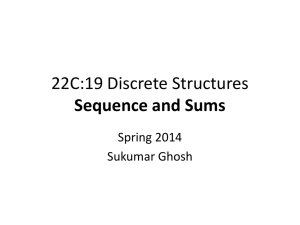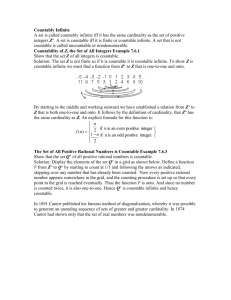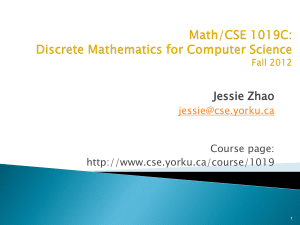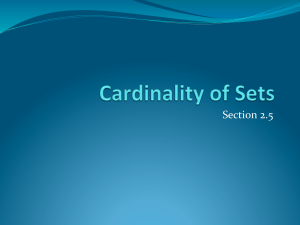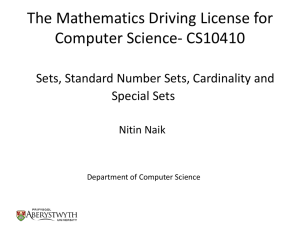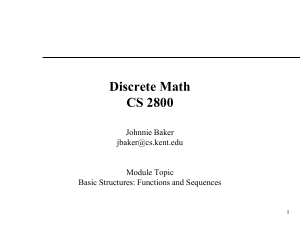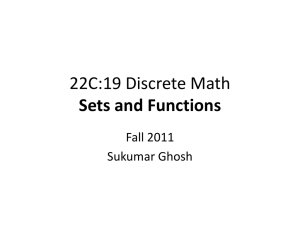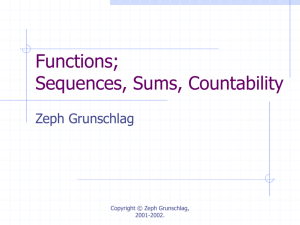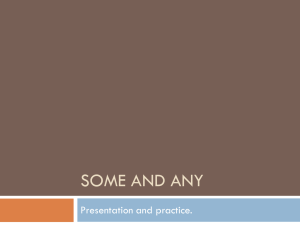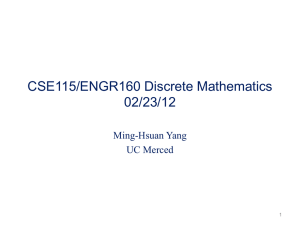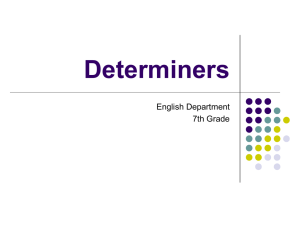Proofs
advertisement
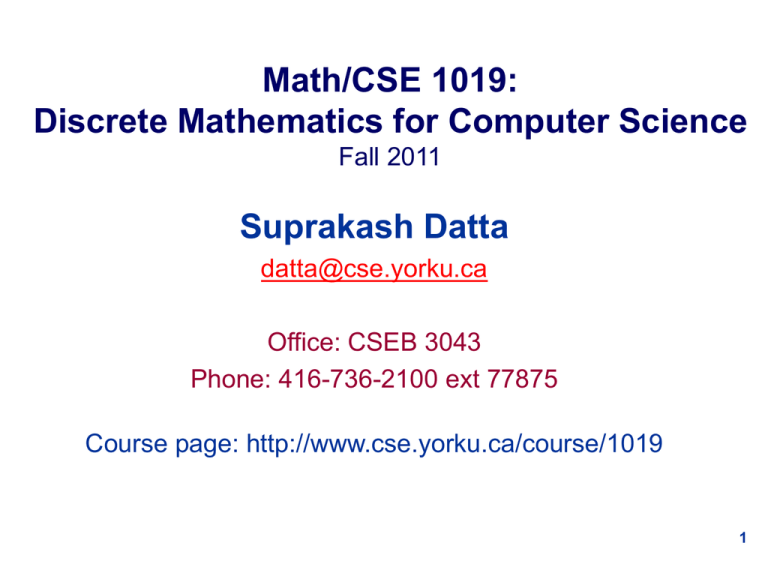
Math/CSE 1019:
Discrete Mathematics for Computer Science
Fall 2011
Suprakash Datta
datta@cse.yorku.ca
Office: CSEB 3043
Phone: 416-736-2100 ext 77875
Course page: http://www.cse.yorku.ca/course/1019
1
Last class: proofs
Different techniques
Proofs vs counterexamples (connections
with quantifiers)
2
Uniqueness proofs
• E.g. the equation ax+b=0, a,b real, a0
has a unique solution.
3
The Use of Counterexamples
All prime numbers are odd
Every prime number can be written as the
difference of two squares, i.e. a2 – b2.
4
The role of conjectures
• 3x+1 conjecture
Game: Start from a given integer n. If n is
even, replace n by n/2. If n is odd, replace
n with 3n+1. Keep doing this until you hit
1.
e.g. n=5 16 8 4 2 1
Q: Does this game terminate for all n?
5
Elegance in proofs
Q: Prove that the only pair of positive
integers satisfying a+b=ab is (2,2).
• Many different proofs exist. What is the
simplest one you can think of?
6
More proof exercises
• If n+1 balls are distributed among n bins
prove that at least one bin has more
than 1 ball
• A game
7
Meaningful diagrams
• Pythagoras
8
Meaningful diagrams - 2
• Sum of an arithmetic series (from
http://www.tonydunford.com/images/math-andgeometry/sum-of-number-series/SumOfOdd.jpg)
9
Meaningful diagrams - 3
• Sum of a geometric series (from
http://math.rice.edu/~lanius/Lessons/Series/one.gif)
10
Meaningful diagrams - 4
• 1/4 + 1/16 + 1/64 + 1/256 + ... = 1/3
(from http://www.billthelizard.com/2009/07/six-visualproofs_25.html)
11
Next
Ch. 2: Introduction to Set Theory
• Set operations
• Functions
• Cardinality
12
Sets
• Unordered collection of elements, e.g.,
–
–
–
–
–
Single digit integers
Nonnegative integers
faces of a die
sides of a coin
students enrolled in 1019N, W 2007.
• Equality of sets
• Note: Connection with data types
13
Describing sets
• English description
• Set builder notation
Note:
The elements of a set can be sets, pairs
of elements, pairs of pairs, triples, …!!
Cartesian product:
A x B = {(a,b)| a A and b B}
14
Sets of numbers
•
•
•
•
•
•
•
Natural numbers
Whole numbers
Integers
Rational numbers
Real numbers
Complex numbers
Co-ordinates on the plane
15
Sets - continued
• Cardinality – number of (distinct) elements
• Finite set – cardinality some finite integer n
• Infinite set - a set that is not finite
Special sets
• Universal set
• Empty set (cardinality = ?)
16
Sets vs Sets of sets
• {1,2} vs {{1,},{2}}
• {} vs {{}} = {}
17
Subsets
• A B: x ( x A x B)
Theorem: For any set S, S and S S.
• Proper subset: A B: x ( x A x
B) x ( x B x A)
• Power set P(S) : set of all subsets of S.
• P(S) includes S, .
• Tricky question – What is P() ?
P() = {}
Similarly, P({}) = {, {}}
18
Set operations
• Union – A B = { x | (x A) (x B)}
• Intersection - A B = { x | (x A) (x B)}
Disjoint sets - A, B are disjoint iff A B =
• Difference – A – B = {x | (x A) (x B)}
Symmetric difference
• Complement – Ac or Ā = {x | x A} = U - A
• Venn diagrams
19
Laws of set operations
• Page 130 – notice the similarities with
the laws for Boolean operators
• Remember De Morgan’s Laws and
distributive laws.
• Proofs can be done with Venn
diagrams.
E.g.: (A B) c = Ac Bc
Proofs via membership tables (page 131)
20
Cartesian products
• AxB
21
Introduction to functions
A function from A to B is an assignment of
exactly one element of B to each element
of A.
E.g.:
• Let A = B = integers, f(x) = x+10
• Let A = B = integers, f(x) = x2
Not a function
• A = B = real numbers f(x) = x
• A = B = real numbers, f(x) = 1/x
22
Terminology
•
•
•
•
•
•
•
•
A = Domain, B = Co-domain
f: A B (not “implies”)
range(f) = {y| x A f(x) = y} B
int floor (float real){ … }
f1 + f2, f1f2
One-to-one INJECTIVE
Onto SURJECTIVE
One-to-one correspondence BIJECTIVE
23
Operations with functions
• Inverse f-1(x) 1/f(x)
f -1(y) = x iff f(x) = y
• Composition: If f: A B, g: C A, then
f ° g: C B, f°g(x) = f(g(x))
24
Graphs of functions
25
Special functions
• All domains: identity (x)
Note: f ° f –1 = f -1 ° f =
• Integers: floor, ceiling, DecimalToBinary,
BinaryToDecimal
• Reals: exponential, log
26
Special functions
•
•
•
•
DecimalToBinary, BinaryToDecimal
E.g. 7 = 1112 , 10012 = 9
BinaryToDecimal – n = 10012 :
n = 1*23 + 0*22 +0*21 + 1*20 = 9
•
•
•
•
•
DecimalToBinary – n = 7:
b1 = n rem 2 = 1, n = n div 2 = 3
b2 = n rem 2 = 1, n = n div 2 = 1
b3 = n rem 2 = 1, n = n div 2 = 0.
STOP
27
Special functions – contd.
• Changing bases: In general need to go
through the decimal representation
• E.g: 1017 = ?9
• 1017 = 1*72 +0*71 + 1*70 = 50
• Decimal to Base 9:
• d1 = n rem 9 = 5, n = n div 9 = 5
• b2 = n rem 9 = 5, n = n div 9 = 0.
• STOP
• So 1017 = 559
28
Special functions – tricks
•
•
•
•
Changing bases that are powers of 2:
Can often use shortcuts.
Binary to Octal:
10111101 = 2758
• Binary to Hexadecimal:
• 10111101 = BD16
• Hexadecimal to Octal: Go through
binary, not decimal.
29
Sequences
• Finite or infinite
• Calculus – limits of infinite sequences
(proving existence, evaluation…)
• E.g.
– Arithmetic progression (series)
1, 4, 7, 10, …
– Geometric progression (series)
3, 6, 12, 24, 48 …
30
Similarity with series
• S = a1 + a2 + a3 + a4 + ….. (n terms)
• Consider the sequence
S1, S2, S3, … Sn, where
Si = a1 + a2 + … + ai
In general we would like to evaluate sums
of series – useful in algorithm analysis.
e.g. what is the total time spent in a
nested loop?
31
Sums of common series
• Arithmetic series
e.g. 1 + 2 + … + n (occurs in the analysis of
running time of simple for loops)
general form iti, ti= a + ib
• Geometric series
e.g. 1 + 2 + 22 + 23 + … + 2n
general form iti, ti= ari
• More general series (not either of the
above)
12 + 22 + 32 + 42 + … + n2
32
Sums of common series - 2
• Technique for summing arithmetic series
• Technique for summing geometric series
• More general series – more difficult
33
Caveats
• Need to be very careful with infinite
series
• In general, tools from calculus are
needed to know whether an infinite
series sum exists.
• There are instances where the infinite
series sum is much easier to compute
and manipulate, e.g. geometric series
with r < 1.
34
Cardinality revisited
• A set is finite (has finite cardinality) if its
cardinality is some (finite) integer n.
• Two sets A,B have the same cardinality
iff there is a one-to-one correspondence
from A to B
• E.g. alphabet (lower case)
• a b c …..
• 1 2 3 …..
35
Infinite sets
• Why do we care?
• Cardinality of infinite sets
• Do all infinite sets have the same
cardinality?
36
Countable sets
Defn: Is finite OR has the same cardinality
as the positive integers.
• Why do we care?
E.g.
– The algorithm works for “any n”
– Induction!
37
Countable sets – contd.
• Proving this involves (usually)
constructing an explicit bijection with
positive integers.
• Fact (Will not prove): Any subset of a
countable set is countable.
Will prove that
• The rationals are countable!
• The reals are not countable
38
The integers are countable
• Write them as
0, 1, -1, 2, -2, 3, -3, 4, -4, ……
• Find a bijection between this sequence
and 1,2,3,4,…..
Notice the pattern:
10
21
So f(n) = n/2 if n even
3 -1
42
-(n-1)/2 o.w.
5 -2
63
39
Other simple bijections
• Odd positive integers
11
23 35
4 7 ….
• Union of two countable sets A, B is
countable:
Say f: N A, g:N B are bijections
New bijection h: N A B
h(n) = f(n/2) if n is even
= g((n-1)/2) if n is odd.
40
The rationals are countable
• Show that Z+ x Z+ is countable.
• Trivial injection between Q+, Z+ x Z+.
• To go from Q+ to Q, use the trick used to
construct a bijection from Z to Z+.
• Details on the board.
41
The reals are not countable
•
-
Wrong proof strategy:
Suppose it is countable
Write them down in increasing order
Prove that there is a real number
between any two successive reals.
- WHY is this incorrect?
(Note that the above “proof” would show
that the rationals are not countable!!)
42
The reals are not countable - 2
•
•
•
•
Cantor diagonalization argument (1879)
VERY powerful, important technique.
Proof by contradiction.
Sketch (details done on the board)
- Assume countable
- look at all numbers in the interval [0,1)
- list them in ANY order
- show that there is some number not
listed
43
Notes
• The cardinality of neither the reals nor
the integers are finite, yet one set is
countable, the other is not.
• Q: Is there a set whose cardinality is “inbetween”?
• Q: Is the cardinality of R the same as
that of [0,1) ?
44
